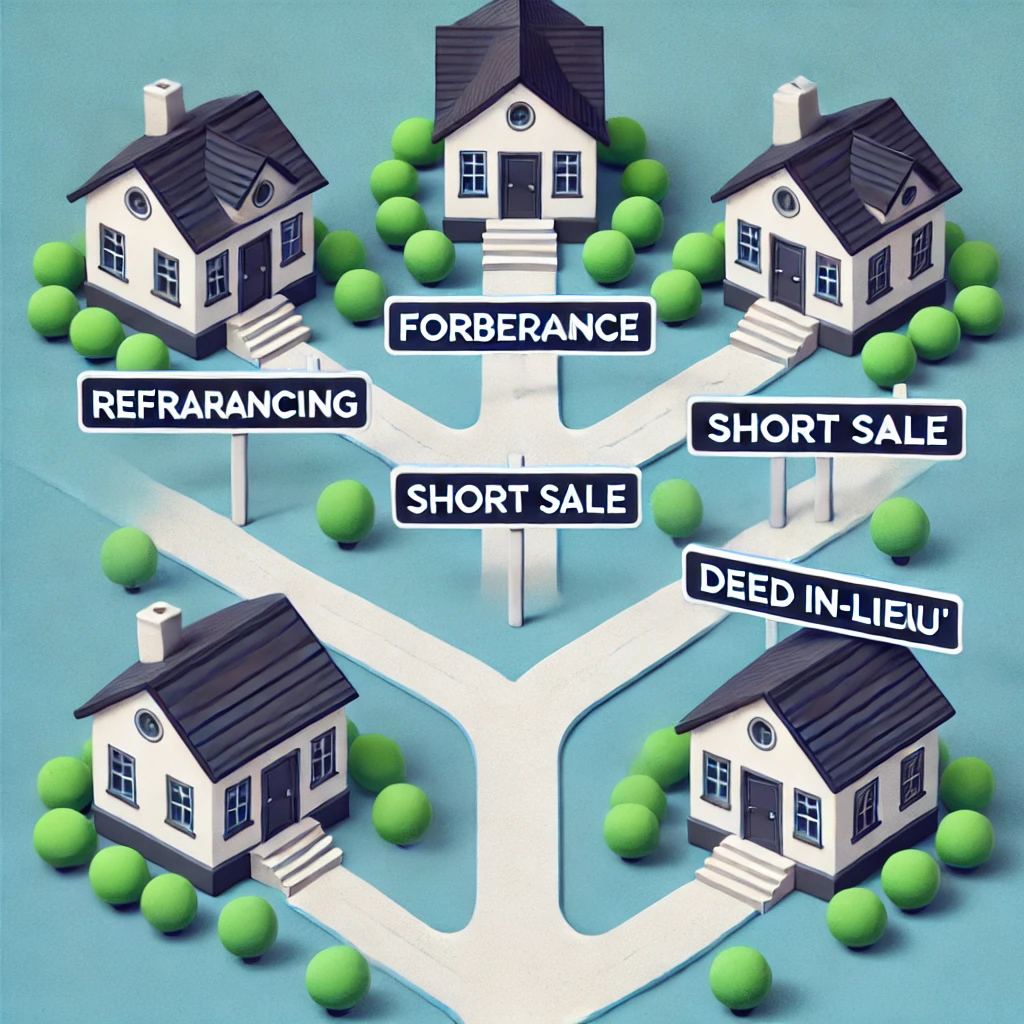
How to Get a Home Loan Modification Approved
How to Get a Home Loan Modification Approved

Are you behind on your mortgage payments and the mortgage lender has initiated the foreclosure process? A loan modification, also known as a mortgage loan modification, modifies the current structure of your loan to relieve you from having to pay the arrears, the missed payments immediately and hopefully keep your monthly mortgage payments manageable based upon your budget.
This guide will walk you through the steps to improve your chances to get a loan modification approved, including common mistakes, essential tips, and strategies for success in the loan modification application process.
In addition to this article there is a large amount of information on the foreclosure process at the following website: Abound-Res.com.
What is a Mortgage Modification?
Unlike refinancing, a mortgage modification doesn’t replace your existing home loan with a new one. Instead, it restructures your existing mortgage loan based on your financial circumstances, potentially reducing your monthly payment.
For instance, if the cause of your financial hardship is that you’ve lost your job, making it impossible for you to stay current on your mortgage payment temporarily, a loan modification could help you avoid foreclosure and stay in your home.
If the cause of your financial hardship is that you’ve experienced an illness that impacted your ability to stay current on your mortgage payment, a loan modification could help you avoid foreclosure and stay in your home
.Understanding Eligibility and Requirements
To be eligible for a loan modification, homeowners typically need to meet certain requirements. These may vary depending on the lender and the type of loan, but common requirements include:
Financial Hardship: Homeowners must be experiencing a financial hardship that is impacting their ability to make mortgage payments. This can include a reduction in income, a job loss, or a medical emergency.
Proof of Income Reduction: Homeowners may need to provide documentation to show that their income has been reduced, such as pay stubs or tax returns.
Proof of Financial Hardship Documentation: Homeowners may need to provide documentation to support their claim of financial hardship, such as medical bills or divorce papers.
Other Requirements: Lenders may have additional requirements, such as a minimum credit score or a certain amount of equity in the home.
The Goal: Avoiding Foreclosure

The primary purpose of a mortgage loan modification is to prevent foreclosure. Foreclosure occurs when the mortgage lender takes back the property, your primary residence, due to missed payments.
This process is not only emotionally distressing for homeowners but also expensive and time-consuming for mortgage lenders, who then have to maintain the property and cover associated costs. Both you and the lender benefit from keeping you in your home, making a modification a win-win solution.
We have prepared an extensive resource of information to help you get the best possible results on our website. Abound-res.com.
Types of Mortgage Modification Programs
There are several types of mortgage modification programs available to homeowners. These may include:
FHA Loan Modification: The Federal Housing Administration (FHA) offers a loan modification program that can help homeowners who are struggling to make mortgage payments. This program can reduce the interest rate, extend the loan term, or reduce the principal balance.
VA Loan Modification: The Department of Veterans Affairs (VA) offers a loan modification program that can help veterans who are struggling to make mortgage payments. This program can reduce the interest rate, extend the loan term, or reduce the principal balance.
Fannie Mae and Freddie Mac Loan Modification: Fannie Mae and Freddie Mac offer loan modification programs that can help homeowners who are struggling to make mortgage payments. These programs can reduce the interest rate, extend the loan term, or reduce the principal balance.
Proprietary Loan Modification: Some lenders offer proprietary loan modification programs that can help homeowners who are struggling to make mortgage payments. These programs may have different requirements and benefits than government-backed programs.
Steps to Get Your Loan Modification Process Approved
Contact Your Lender Early
If you've experienced a financial hardship and are struggling financially or anticipate missed payments, reach out to your mortgage lender or loan servicer immediately. Communicate your intent to get caught up on you home loan, stay in the home and express your willingness to work toward a solution.
Proactively engaging with your mortgage lender or mortgage servicer builds trust and increases the likelihood of approval of the modification process.
Submit Your Application
After initiating contact, you’ll need to complete a loan modification application as part of the loan modification application process. This typically involves writing a Hardship letter explaining your situation, providing proof that the property in question is your primary residence, and detailing your current mortgage payment.
You will need to provide documents to verify your monthly income such as paystubs and/or profit Loss statements and bank statements. Be concise and factual in your explanation—there’s no need for lengthy, emotional narratives.
Provide Only What is Requested
Loan servicers will require specific documentation, such as pay stubs, bank statements, and details of your financial hardship, to process your loan modification application. Submit exactly what they ask for—no more, no less.
Avoid over-sharing, as any additional information could be used to deny your modification request. If you don’t have a requested document, note that in your application to avoid unnecessary delays.
Be Consistent and Proactive
Ignoring calls or letters from your lender can severely damage your chances of approval. Instead, maintain open and consistent communication. Even if your financial situation hasn’t changed, keeping your loan servicer informed shows responsibility and commitment to resolving the issue.
Crafting a Financial Hardship Letter

One of the most critical elements of a loan modification application is the hardship letter. This document explains the circumstances that led to your financial hardship and is crucial to gaining lender empathy and approval. Here are some tips for writing an effective hardship letter:
Focus on External Factors: Mention circumstances beyond your control, such as layoffs, illness, or economic downturns. Avoid discussing personal financial mistakes, as lenders may perceive this as ongoing mismanagement.
Keep it Professional: While it’s essential to explain your situation, avoid emotional language or assigning blame. Instead, stick to the facts and describe how you plan to recover financially.
Show Responsibility Moving Forward: Conclude with a plan for your financial stability, reinforcing your commitment to meeting your obligations in the future.
Alternatives to Loan Modification

While a loan modification can be a helpful solution for homeowners who are struggling to make mortgage payments, it may not be the best option for everyone. Some alternatives to loan modification include:
Refinancing: Homeowners may be able to refinance their mortgage to a lower interest rate or a longer loan term, which can reduce their monthly payments.
Forbearance: Homeowners may be able to temporarily suspend or reduce their mortgage payments through a forbearance agreement.
Short Sale: Homeowners may be able to sell their home for less than the outstanding mortgage balance through a short sale.
Deed-in-Lieu: Homeowners may be able to transfer ownership of their home to the lender in exchange for forgiveness of the mortgage debt.
The Reality of Loan Modification Programs
Having the foreclosure process initiated on your home causes a significant stress on you and all those who are depending upon you. That pressure on top of the stress of the hardship which is the catalyst for falling behind on the monthly mortgage payments can feel unbearable. These compounding pressures are not the ideal environment for making critical future decision.
Here are some of the pitfalls to avoid.
Lenders offering and presenting Loan Modification as readily available:
When you fall behind on your monthly payments your lender will likely offer a loan modification as a solution to correct the situation. Because the immense pressure you are under it is easy to put all your confidence in getting approved and this being your solution.
When you speak to the lender representative the don't do anything to pre-qualify you for the program. They only collect the documents. You will go through a qualifying process very similar to when you applied for the loan initially. They look at things like your credit score, the amount of debt as compared to the amount of income.
A large percentage of applicants get denied approval. If the hardship is continuing to reduce your monthly income there is a likelihood you will not be approved so, while pursuing an approval it is prudent to also be working on a backup strategy.
Be Wary of Companies That Promise to Stop Foreclosure or Guarantee a Loan Modification:
Foreclosures are required to be public record so you will be receiving calls from many people and companies inquiring about your plans. Like anything, you need to be discerning.
Some of these people are good and can help you but there are others that are only seeking an opportunity for their benefit. If you have a company contact you and they say anything guaranteeing they can get you approved for the loan modification that is a BIG RED FLAG. No one can make that guarantee.
Preparing the loan modification application and then the determination to do the necessary follow up with the lender is time consuming and frustrating so it may be that you find qualified assistance but be wary of guarantees and significant upfront fees.
Learn What Option are Available to Stop the Foreclosure Process:
You've heard the saying, "there is more than one way to skin a cat" and it is true for solutions to the foreclosure process.
There is a logical sequence to go through the various ways to stop the foreclosure and a qualified and experienced real estate professional who has helped many manage the process will be of great value to you.
Although the many calls, email, texts, and letters you get offering help can be too much, there are among them people who do have a significant expertise in solving your problems.
Look for the people who can explain all your options and strategies that get you through the problem. Ignore those who are quick to offer you a purchase price, even if it seems like a good price.
The Impact of Loan Modification on Credit
A loan modification can have both positive and negative impacts on a homeowner’s credit score. Some potential impacts include:
Reduced Credit Score: A loan modification can result in a reduced credit score, as it may be reported as a negative event on the homeowner’s credit report.
Improved Credit Score: A loan modification can also result in an improved credit score, as it can help homeowners avoid foreclosure and make timely payments.
Increased Credit Utilization: A loan modification can result in increased credit utilization, as the homeowner may be required to make larger payments or pay off the loan over a longer period of time.
What if Your Application is Denied?
In some cases, lenders may initially deny a loan modification. Don’t be discouraged—persistence can often lead to a favorable outcome. If denied, politely ask for the reason, address any missing documentation, and consider re-submitting your application. Sometimes, even rephrasing your hardship letter can make a significant difference.
Final Thoughts
Getting a loan modification approved is possible with clear communication, timely responses, and a well-crafted hardship letter. By following these steps and maintaining a proactive stance, you can increase your chances of staying in your home and regaining financial stability.
If you have questions or need further guidance on loan modifications, feel free to reach out through our webpage, Abound-Res.com. This information aims to provide clarity and support in navigating the loan modification process, ensuring you have the best chance of approval.